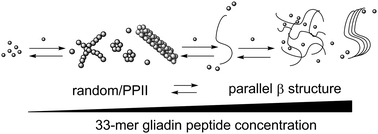Self-assembly of 33-mer gliadin peptide oligomers†
Abstract
The 33-mer gliadin peptide, LQLQPF(PQPQLPY)3PQPQPF, is a highly immunogenic peptide involved in celiac disease and probably in other immunopathologies associated with gliadin. Herein, dynamic light scattering measurements showed that 33-mer, in the micromolar concentration range, forms polydisperse nano- and micrometer range particles in aqueous media. This behaviour is reminiscent of classical association of colloids and we hypothesized that the 33-mer peptide self-assembles into micelles that could be the precursors of 33-mer oligomers in water. Deposition of 33-mer peptide aqueous solution on bare mica generated nano- and microstructures with different morphologies as revealed by atomic force microscopy. At 6 μM, the 33-mer is organised in isolated and clusters of spherical nanostructures. In the 60 to 250 μM concentration range, the spherical oligomers associated mainly in linear and annular arrangements and structures adopting a “sheet” type morphology appeared. At higher concentrations (610 μM), mainly filaments and plaques immersed in a background of nanospherical structures were detected. The occurrence of different morphologies of oligomers and finally the filaments suggests that the unique specific geometry of the 33-mer oligomers has a crucial role in the subsequent condensation and organization of their fractal structures into the final filaments. The self-assembly process on mica is described qualitatively and quantitatively by a fractal diffusion limited aggregation (DLA) behaviour with the fractal dimension in the range of 1.62 ± 0.02 to 1.73 ± 0.03. Secondary structure evaluation of the oligomers by Attenuated Total Reflection FTIR spectroscopy (ATR-FTIR) revealed the existence of a conformational equilibrium of self-assembled structures, from an extended conformation to a more folded parallel beta elongated structures. Altogether, these findings provide structural and morphological information about supramolecular organization of the 33-mer peptide, which might offer new perspectives for the understanding and treatment of gliadin intolerance disorders.


 Please wait while we load your content...
Please wait while we load your content...